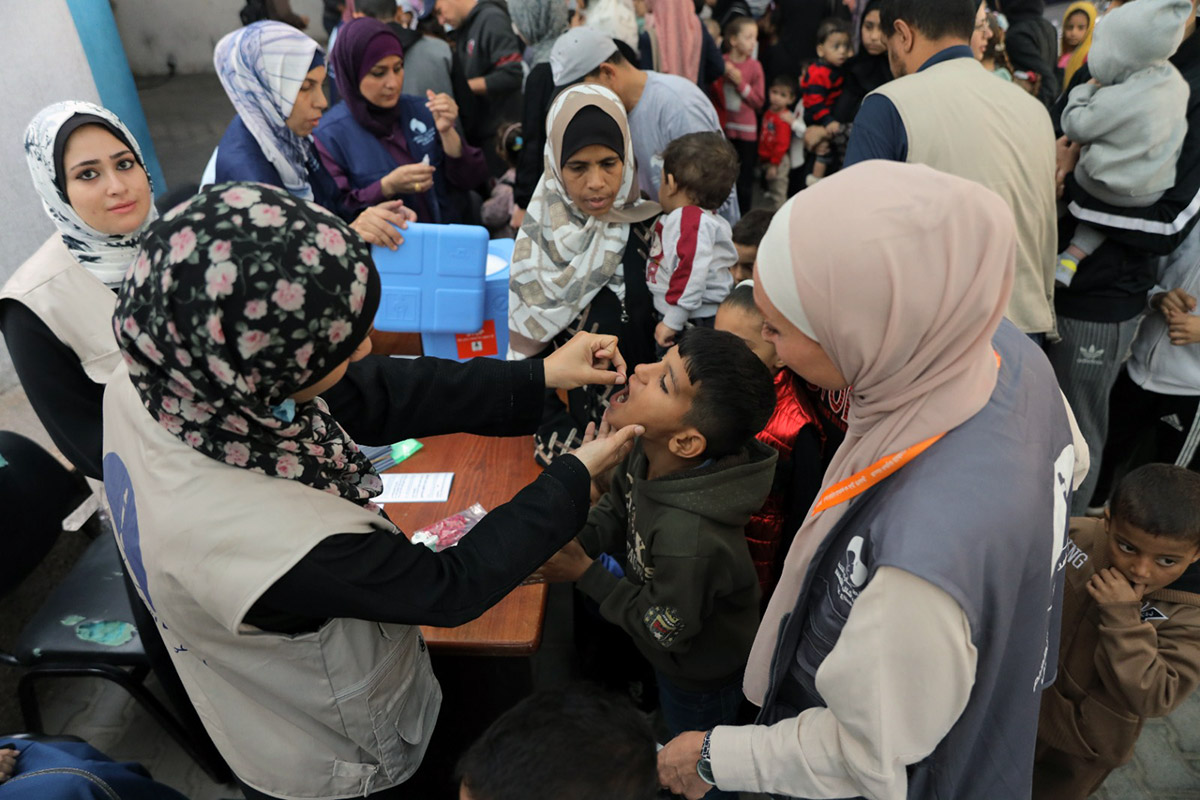
6 November 2024 – The second round of the polio vaccination campaign in the Gaza Strip was completed yesterday, with an overall 556 774 children under the age of 10 being vaccinated with a second dose of polio vaccine, and 448 425 children between 2- to 10-years-old receiving vitamin A, following the three phases conducted in the last weeks.
Administrative data confirm around 94% of the target population of 591 714 children under the age of 10 years received a second dose of nOPV2 across the Gaza Strip, which is a remarkable achievement given the extremely difficult circumstances the campaign was executed under. The campaign achieved 103% and 91% coverage in central and southern Gaza, respectively. However, in northern Gaza, where the campaign was compromised due to lack of access, approximately 88% coverage was achieved according to preliminary data. An estimated 7000-10 000 children in inaccessible areas like Jabalia, Beit Lahiya and Beit Hanoun remain unvaccinated and vulnerable to the poliovirus. This also increases the risk of further spread of poliovirus in the Gaza Strip and neighbouring countries.
The end of this second round concludes the polio vaccination campaign launched in September 2024. This round also took place in three phases across central, south and northern Gaza under area-specific humanitarian pauses. While the first two phases proceeded as planned, the third phase in northern Gaza had to be temporarily postponed on 23 October because of intense bombardments, mass displacements, lack of assured humanitarian pauses and access.
After careful assessment of the situation by the technical committee, comprising the Palestinian Ministry of Health, World Health Organization (WHO), United Nations Children’s Fund (UNICEF), and the United Nations Relief and Works Agency for Palestine Refugees (UNRWA), the campaign resumed on 2 November. However, the area under the assured humanitarian pauses comprising the campaign was substantially reduced, compared to the first round, as the access was limited to Gaza City. Due to hostilities, more than 150 000 people were forced to evacuate from North Gaza to Gaza City, which helped in accessing more children than anticipated.
Despite these challenges, and thanks to the tremendous dedication, engagement and courage of parents, children, communities and health workers, the phase in northern Gaza was completed.
At least two doses and a minimum of 90% vaccination coverage are needed in each community to stop circulation of the polio strain affecting Gaza. Efforts will now continue to boost immunity levels through routine immunization services offered at functional health facilities and to strengthen disease surveillance to rapidly detect any further poliovirus transmission (either in affected children or in environmental samples). The evolving epidemiology will determine if further outbreak response may be necessary.
To fully implement surveillance and routine immunization services, not just for polio but for all vaccine-preventable diseases, WHO and UNICEF continue to call for a ceasefire. Further, apart from the attack on the primary healthcare centre, the campaign underscores what can be achieved with humanitarian pauses. These actions must be systematically applied beyond the polio emergency response efforts to other health and humanitarian interventions to respond to dire needs.
Notes to editors:
The polio campaign, being conducted by the Palestinian Ministry of Health in collaboration with the World Health Organization (WHO), the United Nations Children’s Fund (UNICEF), the United Nations Relief and Works Agency for Palestinian Refugees (UNRWA), and other partners, was part of emergency efforts to stop a polio outbreak in Gaza, which was detected on 16 July 2024, and to prevent further spread of poliovirus.
Since July 2024, circulating variant poliovirus type 2 has been confirmed in Gaza in 11 environmental samples has been confirmed in Gaza in a 10-month-old paralysed child (in August 2024).


